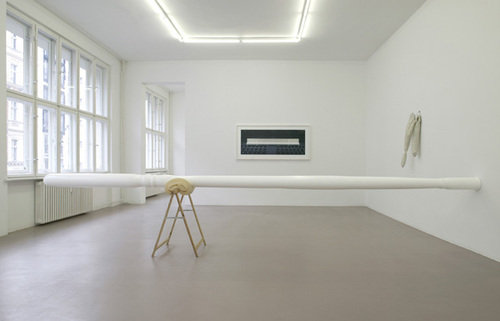Friederike Feldmann | Erik Steinbrecher
dal 28/2/2008 al 28/3/2008
Segnalato da
28/2/2008
Friederike Feldmann | Erik Steinbrecher
Galerie Barbara Weiss (old location), Berlin
Counter Images. The exhibition presents the crude encounter of Feldmann's austere painting and Steinbrecher's sculptures cast in aluminium. Their practices reflect on their claim to universal validity and detach and separate the image from the image object or the form from the object in a seemingly playful yet precise manner.

/Counter Images/ would be a hypothetical title for the exhibition of
Friederike Feldmann and Erik Steinbrecher. The show has no title,
however, since the crude encounter of Feldmann's austere painting and
Steinbrecher's sculptures cast in aluminium do not require any addition.
/Yet image, reproduction, cast, imitation, copy, doublet, mimicry,
replica, side piece, double/, synonyms of the term counter images,
outline the content-related aspects and describe the technical approach
of the two artists. Friederike Feldmann and Erik Steinbrecher take up
existing, everyday objects (Steinbrecher) and images (Feldmann), reflect
on their claim to universal validity and detach and separate the image
from the image object or the form from the object in a seemingly playful
yet precise manner.
These thought and action processes of reversal, detachment and turning
inside out resemble technical reproduction procedures. They additionally
evoke a new visual image ground or a layer of perception lying between
colour and picture medium, between cast and source material.
The rolls and sausages covered with aluminium, additionally alienated
from their original materiality by a shining powder coating, and the
floral and chain-like applications of Erik Steinbrecher's sculptures, at
times woven to a lamp and a sculpture, point to the conceptual void of
grasping and defining everyday or useless objects and forms. What
remains in the end are curious objects, citations of everyday life that
refer to the ways in which mass products are used.
Friederike Feldmann divides black into cyan, magenta and yellow
according to the subtractive colour mixture, creating disturbing
fuzziness by means of meticulously painted overlappings and layers that
remind one of misprints, and adding her reflection on gestural painting,
which she calls "how to paint action painting", on the canvas, which is
at once picture medium and colour element.
Both artists place their works in one room, thus marking a clash, a
mutual provocation and the inevitability of a common, closely linked
mode of perception: Visually running along curved and shiny white
surfaces, following and trying to untangle the overlapping, whirring
lines is seductive and at the same time prompts one to resolve the
staged deceptions and irritations of image and reproduction, of original
form and copy.
Birgit Szepanski
The painter /Friederike Feldmann/ is known for her depictions of Baroque
interiors, altars and Oriental carpets. In 2005 she began a picture
series on painting of the 1950s and 60s for her contribution to the
exhibition 50 Jahre documenta (Kassel). In 2006 she created an extensive
wall painting on this theme at Galerie Barbara Weiss. The publication 21
Bilder has recently appeared at Verlag der Buchhandlung Walther König.
In his photo series, videos, sculptures and interventions, /Erik
Steinbrecher,/ who is known for his solo shows at Kunst-Werke, Berlin,
P.S.1, New York and documenta X in Kassel, addresses themes such as
phenomena of everyday life, industrial and mass products, ironizing and
defamiliarizing them in the context of art. New works are on view in the
group exhibition Mimétisme, Extra City Centrum for Contemporary Art,
Antwerp. Recent publications include: Superfundi, Centre de la
photographie Genéve, JRP/Ringier, 2007; Stubborn Statue, Erik
Steinbrecher/Tomas Kadlcik, Centre de la photographie Genéve, Kodoji
Press, 2008.
image by Erik Steinbrecher
Opening Friday February 29, 2008 7-9 pm
Galerie Barbara Weiss
Zimmerstrasse 88-91 - Berlin
Free admission



